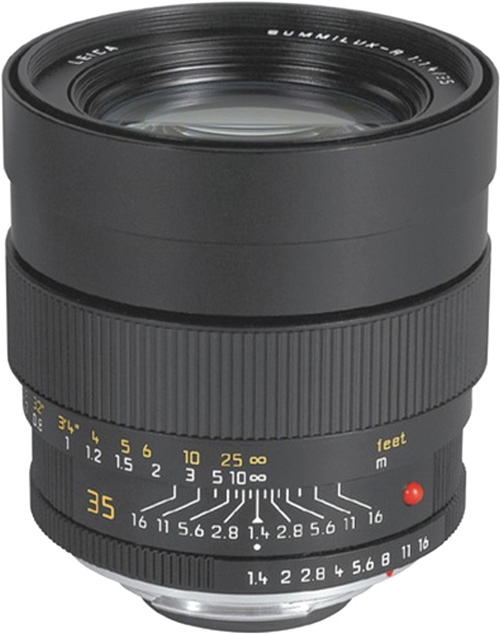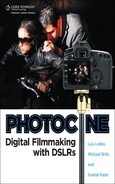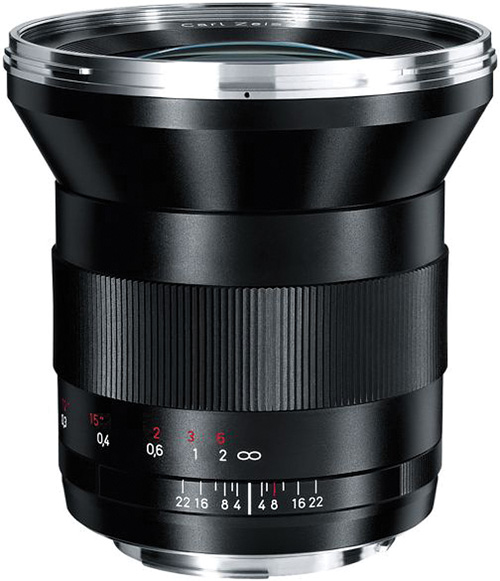
Still lenses were designed and manufactured for single lens reflex (SLR) cameras and, as mentioned in Chapter 2, they are made with short focusing throws optimized for still photography. Most modern still lenses have built-in autofocus mechanisms driving small motors that quickly move lightweight, sometimes plastic, internal gears to the desired focal position. Still lenses generally cost less than specialty cinema lenses, and the trade-off for speed and affordability is lower tolerances in precision and repeatability. There’s a certain amount of looseness that’s generally acceptable for still applications where the goal is a quick focus and shutter actuation. Size and weight along with mass production considerations also affect the overall build quality and performance of still lenses. Issues that arise when shooting motion with still lenses include:
Looseness in lens mechanisms makes focusing while recording difficult
Aperture clicks into place every third or half stop, which hinders adjusting exposure while recording
Focus distance marks on lens barrel aren’t accurate, making it hard to pull focus externally
No external gears for follow focus
Lenses aren’t calibrated to hold focus during a zoom
Noticeably breathing when focusing causes the image to appear to zoom in and out
No hard stops at zero or infinity
Cinema lenses have much tighter tolerances and overall build quality. The internal components are usually metals or alloys and are designed to hold focus and maintain calibration while changing aperture settings and zooming simultaneously. They are also made with long focusing throws to aid in focusing complex movements. Of course, this is reflected in the higher prices paid for cinema style lenses. A good cinema lens can easily cost more than a new BMW and sometimes as much as a suburban house.
A lot of cinema lenses use a mount standard called PL (positive lock).
Using a PL-mount lens on a DSLR camera isn’t as easy as slapping on an adapter. A PL mount sits in the camera pretty deep. This is one of the reasons it locks positively to the camera. On a DSLR, the mirror box mechanism pops up out of the way when taking a still. If the rear lens element sits too deep, the mirror will hit the lens and the camera will break. There are companies like Hot Rod Cameras in Hollywood (http://www.hotrodcameras.com/products/lens-mount-kits/pl-mount-and-mods/) that will modify a Canon 7D by removing the whole mirror assembly and adding a PL lens mount calibrated to the DSLR sensor. This isn’t a cheap process, and the converted camera basically becomes a dedicated video camera.

Photo of PL mount on rear of cinema lens
Carl Zeiss has been a strong brand in the cinema world for a while now and found itself in a great position in the emerging HDSLR filmmaker market because it is one of the few lens manufacturers in the world still producing non-autofocus lenses. Its SLR lenses were designed for still photography, but because they are made with tighter tolerances and higher standards, many HDSLR shooters have gravitated to them for filmmaking. They still have fairly short throws (distance from zero to infinity), and the distance markers on the lens are just rough approximations like most still lenses. However, the quality of the imagery produced is superb, and they adapt better for cinematography than autofocus lenses.
Not to rest on their laurels, Zeiss took its CP line, which was developed for the RED Camera and adapted from its SLR lenses, and created the CP.2 lenses with HDSLR cinema in mind. These lenses share the glass and most of the components from the SLR line shrouded in a cinema style housing with built-in follow focus gearing and a few more blades in the aperture. They also share the same barrel diameter and front ring size. This means that once a lens is added to the camera and the matt box and rigging adjusted for proper fit, you won’t have to break everything down and rebuild every time you change lenses. The glass and coatings are also color matched, so when you change a lens, the contrast and saturation and overall look shouldn’t change. To top this cherry of a lens system, Zeiss has created the first interchangeable mount system for cinema lenses.
A simple mechanical change, and you can go from Canon EF mount to PL mount and vice-versa. They recently expanded the options to include Nikon mount, Micro Four Thirds mount, and Sony Alpha mount. The CP.2 lenses can grow with you to practically any camera system you find yourself using. Zeiss CP.2 lenses run about $3,900 each, which is expensive for the stills crowd but pretty inexpensive in the cinema world.
There are modifications that can be done to still lenses to make them more cinema-like. One of the places I trust in Los Angeles is Duclos Lenses. Paul Duclos and his son Matthew are total lens geeks who seem to know everything there is to know about still and cinema glass. They have a cine-mod service for around $250. From their website:
“The cine-mod is a modification done to many “still photo” lenses to make them more user friendly to motion picture applications. The standard Duclos Lenses Cine-Mod consists of a solid delrin focus gear, de-clicking the iris, and installing a 80mm front ring. All of these details can be customized and altered to fit your needs.”
I highly recommend their cine-mod service for your still lenses. Just having the pressure-fitted low profile Delrin gear added to the lens is a huge benefit when shooting HDSLR cinema. It allows you to lose the bulky gear adapters and save time between setups. It’s also a good thing to have all your front ring sizes the same for your filters and matt box.
Another quick thing I want to mention from Duclos is its modified 11-16mm Tokina lens. They pull this lens apart and rehouse it in anodized aluminum, while reinforcing and refining the internal components. The final product is a small, lightweight lens perfectly capable of holding its own against the likes of other motion picture optics. This hand-built service will cost you $3,500, but the result is a very capable wide zoom for HDSLR cinema. At the 2010 PhotoCine Expo, Matthew showed me a prototype of a Nikon 70-200 zoom rebuilt like the Tokina. This conversion will probably run you closer to $10K, but it promises to be an amazing cinema zoom. The guys at Duclos are lens-mad scientists.
One more thing I want to mention about still lenses on HDSLR cameras is the use of adapters. There are adapters that allow you to shoot almost any lens on any camera, especially when you’re using a camera with no mirror box like the Panasonic GH1 or GH2 or other EVIL (Electronic Viewfinder, Interchangeable Lens) cameras. Don’t cheap out when buying an adapter. Cheap ones will have looser tolerances and start slipping immediately. Fotodiox is one that a lot of people choose because of the price/performance matrix. Matthew Duclos has written an article on his personal blog (http://matthewduclos.wordpress.com/2010/04/19/fotodiox-mount-adaptor-reviews/):
“Fotodiox makes a lot of mount adaptors including a Nikon: EOS and Leica R: EOS. Perfect for this application. The difference in quality has a lot to do with tolerances and material. Although most people think the mount on a DSLR is steel, it’s not... They are almost always made of brass and then nickel-plated to look nice. The same goes for the mount adaptors offered by many companies. The higher quality adaptors are made of anodized aluminum or stainless steel. Fotodiox offers two versions of both adaptors I tested. A “pro” and a normal. All in all, Fotodiox did a great job of covering the bases. The “Pro” versions are in fact better than their standard counterparts, but I would not consider them professional since a professional would be using gear that is functional as-is. That said, the pricing is spot on. The standard adaptors are $28 each and the “pro” versions are just shy of $90 a piece.”
Another tidbit I picked up from Shane’s blog is to use IS 1 (image stabilization):
“The image stabilization function on the 300mm, 600mm, 70-200mm zoom and the 100-400mm zoom is awesome. I have handheld 300mm shots with the image stabilizer beautifully. Do not use IS II because it moves the image in a way that does not feel organic and softens the image.”
Shane Hurlbut, Rodney Charters, ASC, and many other professional cinematographers have repeated the mantra “it’s all about the glass,” and I would have to agree with them. Cameras are becoming a consumer electronics commodity and will continue to follow the life trajectory of computers and televisions, getting faster and better while dropping in price. I predict that a professional image maker will own a set of lenses and then choose the camera best suited for a particular job, no longer being tied to a closed system based on a single camera brand. Luckily, when shooting HDSLR video, you can choose from a multitude of glass at a wide range of price points in both the still and cinema lens categories.

Canon L series 85mm

Nikon Al series 28mm

Nikon Al series 50mm

Leica 35mm R series

50mm Hasselblad medium format

150mm Hasselblad medium format


